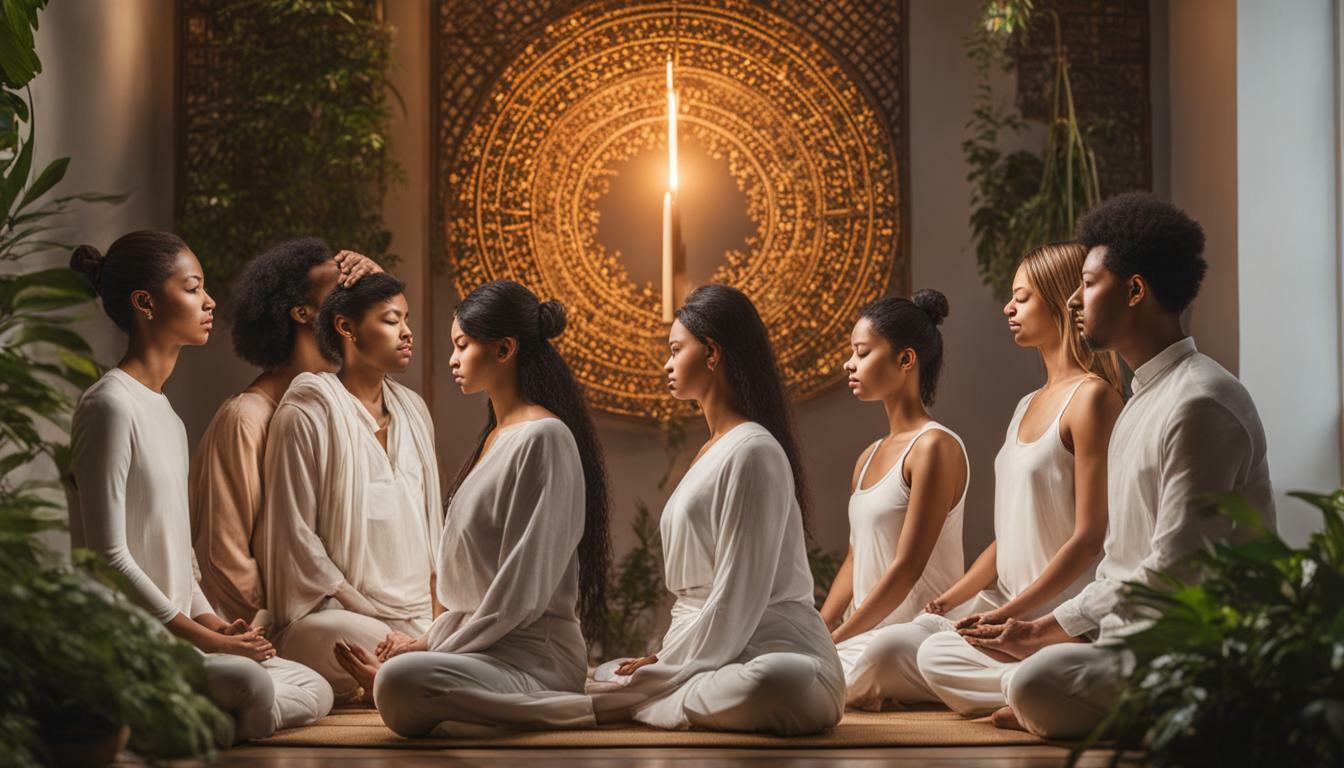Leading a meditation group can be a fulfilling and enriching experience that allows you to create a supportive community and guide others on their meditation journey. Whether you are a seasoned meditator or just starting out, leading a group can provide numerous benefits, including accountability, a sense of connection, and the opportunity to deepen your own practice.
Key Takeaways:
- Leading a meditation group offers the opportunity to create a supportive community and guide others on their meditation journey.
- Establishing basic guidelines and structure for your group meetings can ensure a focused and productive meditation experience.
- Activities such as sitting meditation, guided meditation, readings, discussions, and themed meditations can be incorporated into your group sessions.
- As a facilitator, it is important to create a safe and stable atmosphere, guide discussions, and encourage mindful sharing among participants.
- Promoting your meditation group can be done through various channels, such as flyers, online listings, local news sources, and word of mouth.
Establishing Guidelines for Your Meditation Group
To create a stable and harmonious meditation group, it is essential to establish clear guidelines that promote respect, mindfulness, and a safe space for all participants. These guidelines will serve as a foundation for your group, ensuring that everyone feels comfortable and supported throughout their meditation journey. Here are some key tips to help you establish effective guidelines for your meditation group:
- Set the tone: Begin each session by setting an intention or theme, allowing participants to align their focus and energy. This can create a sense of purpose and unity within the group.
- Create structure: Structure is important in providing a framework for your meditation sessions. Set a schedule, specify the duration of each practice, and include breaks if necessary. Clearly communicate the format and expectations to participants.
- Encourage mindful communication: Foster an environment of open and respectful communication. Emphasize active listening and encourage participants to share their experiences and insights without judgment. Use a talking stick or any other object as a visual cue to ensure everyone has a chance to speak.
- Ensure confidentiality: Confidentiality is essential in creating a safe space for individuals to explore their inner experiences. Establish a clear policy regarding confidentiality and emphasize that what is shared within the group should remain confidential.
“Setting clear guidelines for your meditation group is like creating a container for deep transformation to occur. By establishing a safe and supportive environment, you lay the groundwork for personal growth and collective healing.” – Meditation Group Facilitator
Benefits of Establishing Guidelines
Establishing guidelines for your meditation group not only creates a sense of structure and safety, but it also promotes respect and mindfulness among participants. When everyone is aware of the expectations and boundaries, it allows for a more focused and meaningful meditation experience. Here are some key benefits of establishing guidelines:
- Improved focus: Clearly defined guidelines help participants remain focused during meditation, reducing distractions and enhancing the depth of their practice.
- Enhanced trust: When participants feel that their personal experiences and vulnerabilities are respected and held in confidence, it builds trust within the group.
- Facilitated growth: Guidelines provide a supportive framework for personal growth and exploration. They offer a safe space for individuals to dive deeper into their meditation practice and share their insights.
- Stronger connection: By establishing guidelines that encourage mindful communication and active listening, participants can forge deeper connections and develop a sense of community within the group.
By following these tips and establishing clear guidelines, you can create a meditation group that offers a transformative and enriching experience for everyone involved. Remember, the guidelines you set will serve as a roadmap for your group, fostering a sense of community, accountability, and growth.
Table: Sample Guidelines for Your Meditation Group
| Guideline | Explanation |
|---|---|
| 1. Respectful Listening | Practice active listening without interrupting or judging others. Give each participant an opportunity to express themselves. |
| 2. Confidentiality | Emphasize the importance of maintaining confidentiality within the group, ensuring that personal experiences shared during sessions remain private. |
| 3. Mindful Sharing | Encourage participants to speak from their own experiences, using “I” statements, and avoid giving unsolicited advice or engaging in debates. |
| 4. Respectful Boundaries | Remind participants to respect each other’s personal space and boundaries, both during meditation sessions and outside of the group. |
| 5. Non-judgment | Promote an environment free from judgment, where individuals feel accepted and supported on their meditation journey. |
| 6. Punctuality | Encourage participants to arrive on time to maintain the flow and integrity of the meditation session. |
Activities for Your Meditation Group
Engaging in diverse activities during your meditation group sessions can enhance the experience and offer participants a range of mindfulness techniques to explore. By incorporating different activities, you can cater to the varying needs and preferences of your group members, creating a well-rounded and enriching meditation practice.
Sitting meditation: This classic meditation technique involves sitting in a comfortable position and focusing on your breath, sensations, or a specific point of focus. It cultivates mindfulness and allows participants to develop a steady and calm state of mind. Encourage your group members to maintain a consistent posture and gently guide them to return to their breath whenever their mind wanders.
Guided meditation: Guided meditations provide verbal instructions and visualization to help participants relax and deepen their meditation practice. You can create your own guided meditations or use pre-recorded ones that align with the theme or intention of the session. Incorporating variations such as body scans, loving-kindness meditations, or nature visualizations can add variety and interest.
“The present moment is the only time over which we have dominion.” – Thích Nhất Hạnh
Readings and discussions: Selecting relevant texts or passages on mindfulness, spirituality, or personal growth can inspire reflection and discussion within the group. Encourage participants to share their thoughts, insights, and questions related to the readings. This creates a sense of community and fosters deeper connections among the members.
Meditating on a specific theme: Choose a specific theme for each meditation session, such as gratitude, compassion, or self-acceptance. Discuss the theme beforehand and guide the participants to reflect and meditate on it. This focused approach allows individuals to explore specific aspects of their lives and cultivate mindfulness around a particular quality or intention.
| Benefits of Engaging in Various Activities | Benefits of Engaging in Various Activities |
|---|---|
| Offers a diverse range of mindfulness techniques | Promotes engagement and participation |
| Prevents monotony and boredom | Caters to different learning styles and preferences |
| Fosters a sense of exploration and discovery | Enhances depth and breadth of the meditation practice |
By incorporating a mix of activities, you can create a dynamic and engaging meditation group that supports the growth and well-being of its participants. Remember to observe and adapt based on the needs and interests of your group members, as this will ensure a fulfilling and transformative meditation experience for all.
Facilitating Group Meditation and Discussion
As the facilitator, your role is to create a safe and supportive environment while guiding the meditation and discussion to ensure a meaningful and focused experience for all participants. Establishing a conducive atmosphere can be achieved by carefully selecting the location and setting the tone for the session. Whether you choose to host the group meditation in your home or a yoga studio, create a calming and peaceful space that promotes relaxation and introspection.
During the meditation session, guide participants through different techniques such as breathing exercises, visualization, or body scans. Encourage them to find a comfortable position and maintain a gentle focus on their breath or chosen object of meditation. Emphasize the importance of non-judgmental awareness and remind participants to kindly bring their attention back to the present moment whenever their mind wanders.
| Tip: | Consider playing soft instrumental music or using nature sounds to enhance the meditative experience and create a serene ambiance. |
|---|
After the meditation, facilitate a discussion where participants can share their experiences, insights, and any challenges they encountered during the practice. Encourage mindful sharing by setting guidelines that promote active listening and respect for others’ perspectives. This can include reminding participants to speak from their own experience, avoid interrupting others, and maintaining confidentiality within the group.
Nurturing a Supportive Environment
A supportive environment is vital for a meditation group to thrive. Emphasize the importance of fostering trust, empathy, and non-judgment among participants. Encourage open-mindedness and remind members that everyone’s meditation journey is unique. This helps to create a space where individuals feel comfortable sharing their personal experiences and challenges.
Remember, the goal is not to compare oneself to others, but to support one another in cultivating mindfulness and compassion.
To promote a confidential and supportive atmosphere, consider implementing the following guidelines:
- Remind participants that what is shared in the group should remain within the group
- Encourage active listening and empathetic responses
- Discourage giving unsolicited advice or judgments
- Create a safe space where individuals can express themselves without fear of criticism or ridicule
By establishing these guidelines and nurturing a supportive environment, you can create a meditation group that provides a sense of community, connection, and personal growth for all participants.
Promoting a Supportive Environment
Cultivating a supportive environment is crucial in a meditation group, as it allows individuals to open up, share their experiences, and feel supported on their meditation journey. When participants feel safe and encouraged, they are more likely to engage in authentic and meaningful discussions, enhancing the overall group experience.
To foster a supportive atmosphere, it is important to establish guidelines for mindful sharing. Encourage participants to listen actively and attentively to each other’s experiences without judgment or interruption. This creates a space where individuals can express themselves honestly and without fear of criticism.
Confidentiality is another key aspect of creating a supportive environment. Emphasize the importance of keeping shared experiences and personal information within the group. This builds trust among participants, allowing them to feel secure in sharing their thoughts and feelings without concern about privacy.
In addition to guidelines, it can be helpful to incorporate group activities that promote empathy and connection. For example, you can encourage participants to pair up and engage in reflective listening exercises, where they take turns sharing and listening attentively to one another. This not only strengthens the bond between members but also fosters a deeper understanding and compassion.
| Benefits of a Supportive Environment | Guidelines for a Supportive Environment |
|---|---|
| – Encourages openness and vulnerability – Enhances trust and empathy – Supports personal growth and transformation |
– Encourage active and non-judgmental listening – Maintain confidentiality – Incorporate activities that foster connection and understanding |
Quote:
“Creating a supportive environment within a meditation group is like planting seeds of trust and empathy. When nurtured, these seeds grow into a flourishing community where individuals can flourish in their meditation practice.” – Jane, Meditation Group Facilitator
A supportive environment not only benefits individual participants but also contributes to the overall success and longevity of the meditation group. When individuals feel heard, understood, and supported, they are more likely to continue attending sessions and actively engage in their meditation practice. This, in turn, strengthens the group dynamic and fosters a sense of collective growth.
By prioritizing a supportive environment in your meditation group, you create a space where individuals can connect with like-minded individuals, share their experiences, and find solace in the mutual journey towards inner peace and self-discovery.
Spreading the Word about Your Meditation Group
Getting the word out about your meditation group is essential to attract members and create a thriving community of like-minded individuals. By utilizing various methods of promotion, you can reach a wider audience and increase the chances of finding individuals who are interested in joining your group. Here are some meditation group tips to help you successfully promote your group and attract new members.
Create Flyers: One effective way to spread the word about your meditation group is by creating visually appealing flyers. Include important information such as the date, time, and location of your group meetings, as well as a brief description of what participants can expect. Distribute these flyers in local community centers, yoga studios, libraries, and other relevant locations where potential participants may frequent.
Utilize Online Listings: Take advantage of online platforms and directories that cater to individuals interested in meditation. Websites like Meetup, Eventbrite, and local community forums can help you reach a wider audience and connect with individuals seeking meditation groups in your area. Post detailed information about your group, including its purpose, format, and any requirements or guidelines prospective members should be aware of.
| Media | Description |
|---|---|
| Social Media | Utilize social media platforms, such as Facebook and Instagram, to create a dedicated page or event for your meditation group. Regularly post updates, inspirational quotes, or relevant articles to keep your followers engaged and informed about upcoming group sessions. |
| Local News Sources | Reach out to local news outlets that feature community events and activities. They may be interested in running a story or including your meditation group in their event listings. Contact them with a brief description of your group and how it benefits the community. |
| Word of Mouth | Spread the word about your meditation group through your personal network and invite friends, family, or colleagues who might be interested. Encourage your current members to invite others as well. Word of mouth is a powerful tool for attracting like-minded individuals who are more likely to actively participate in the group. |
Remember, consistency and authenticity are key when promoting your meditation group. Be clear about the purpose and format of your group, and highlight the benefits participants can expect. By utilizing a combination of offline and online promotional strategies, you can attract individuals who resonate with your group’s vision and create a supportive community that fosters growth and transformation through meditation.
Deepening the Practice with Retreats and Email Lists
Hosting group retreats and establishing an email list can offer additional avenues for group members to deepen their meditation practice and strengthen their connection with the group. Retreats provide an opportunity to immerse oneself in a dedicated meditation environment, away from the distractions of daily life. It allows participants to deepen their practice, explore new techniques, and connect with like-minded individuals on a deeper level.
During a retreat, group members can engage in longer meditation sessions, participate in guided practices, and benefit from the collective energy of the group. Retreats often include elements such as walking meditation, mindful movement, and silent meals, which help cultivate mindfulness in different contexts. These experiences can contribute to a profound sense of tranquility, self-discovery, and personal growth.
An email list serves as a valuable tool for keeping group members informed and engaged between meetings. It allows the facilitator to share resources, articles, guided meditations, and updates about upcoming sessions or retreats. The email list also provides a platform for members to ask questions, share their experiences, and offer support and encouragement to one another.
| Benefits of Group Retreats | Benefits of Email Lists |
|---|---|
|
|
By combining group retreats and an email list, meditation groups can create a comprehensive support system for their members. This holistic approach enables participants to deepen their practice, receive ongoing guidance and inspiration, and develop meaningful connections within the group. Whether it’s through the transformative experience of a retreat or the continuous support of an email list, these additional avenues provide valuable opportunities for growth and enrichment in one’s meditation journey.
Conclusion
Leading a meditation group provides an opportunity for personal growth, community building, and supporting others on their path to mindfulness. It is a rewarding experience that can bring immense joy and fulfillment. By guiding a meditation group, you not only deepen your own practice but also create a supportive space for others to explore and cultivate their own inner journeys.
Whether you choose to lead a small intimate group or a larger gathering, there is no set number of participants required for a successful meditation group. The size can vary based on the format you choose, whether it is an open group welcoming new members or a closed group that maintains a consistent core. Establishing basic guidelines for the group meetings can provide structure and help orient new members, ensuring a smooth and focused meditation experience for everyone involved.
As a facilitator, your role is crucial in creating a safe and stable atmosphere for the group. You will guide the discussion, keep the group focused, and encourage mindful sharing among participants. By fostering a supportive and confidential environment, you can help build trust and empathy among group members, fostering deep connections and personal transformation.
Spreading the word about your meditation group is important to attract like-minded individuals who are seeking the benefits of group meditation. Utilize various strategies such as creating flyers, leveraging online listings, utilizing local news sources, and tapping into the power of word of mouth. Additionally, organizing group retreats and establishing an email list can provide further opportunities for members to deepen their practice and stay connected.
Embarking on the journey of leading a meditation group is a beautiful way to share the transformative power of meditation with others. By creating a space for collective introspection and growth, you not only support the personal well-being of others but also contribute to building a more mindful and compassionate society. So, take the first step today and start leading your own meditation group. The path to mindfulness awaits!
What Are Some Tips for Leading a Successful Meditation Session?
Leading a successful meditation session requires incorporating proper meditation techniques. Begin by creating a calm and serene environment, free from distractions. Encourage participants to find a comfortable seated position and focus on their breath. Provide gentle guidance, allowing individuals to explore their thoughts without judgment. Finally, ensure the session ends with a gradual transition back to the present moment.
Is Choosing a Mantra Important in Leading a Meditation Group?
Choosing a mantra is crucial when leading a meditation group. The mantra selection guide helps instructors identify appropriate mantras that resonate with participants. A well-chosen mantra can enhance focus, promote relaxation, and create a sense of unity within the group. It establishes a foundation for a profound, transformative meditation experience.
FAQ
Q: How many participants are needed for a successful meditation group?
A: There is no set number required for a successful group. The size can vary based on the open or closed group format.
Q: What activities can be included in a meditation group session?
A: The group format can include activities such as sitting meditation, guided meditation, readings, discussions, and meditating on a specific theme.
Q: What does it mean to be a facilitator in a meditation group?
A: Being a facilitator involves creating a safe and stable atmosphere while guiding the discussion and keeping the group focused.
Q: How can I ensure a supportive and confidential environment in my meditation group?
A: Mindful sharing is an important aspect of group meditation. Guidelines can be established to ensure a supportive and confidential environment.
Q: How can I promote my meditation group and attract new members?
A: You can get the word out about your group through flyers, online listings, local news sources, and word of mouth.
Q: How can I provide additional opportunities for members to deepen their practice?
A: Hosting group retreats or establishing an email list can provide additional opportunities for members to deepen their practice and connect with each other.
Q: Where can I host my group meditation sessions?
A: You can choose an appropriate location such as your home or a yoga studio to host your group meditation sessions.
Q: How can I invite people to join my meditation group?
A: You can invite people through personal invitations, creating a Facebook event, sending emails or Evites, or creating a Meetup group.
Q: Is it beneficial to set a shared intention for the meditation?
A: Yes, setting a shared intention can enhance the collective experience of the group meditation.








